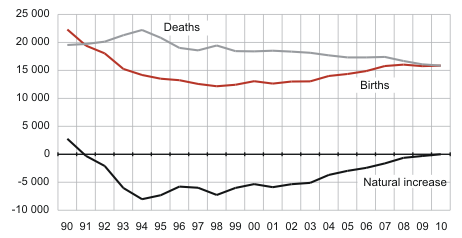According to preliminary data natural increase is narrowly negative
15,842 births, i.e. 79 births more than in 2009, were registered in 2010. 15,847 deaths were registered i.e. 234 deaths less than in the previous year. 5,091 marriages were contracted and 2,994 marriages ended in divorce which is correspondingly 271 and 194 less than a year ago.
The number of deaths has been rapidly decreasing during the last three years, life expectancy has quickly increased and the number of the elderly among the population has risen. Balance of natural increase has been achieved due to that. The number of births has been relatively stable for four years already – total fertility rate that shows the average number of children per woman at childbearing age is a bit higher than 1.6. This indicates that the current balance of natural increase does not ensure the persistence of Estonian population in a longer-term perspective. With a view to achieving the population reproduction level, the total fertility rate should be at least 2.1 or on average over 2 children per woman. To reach such a level, the number of births should continue growing.
Births, deaths and natural increase, 1990–2010
Statistics Estonia will publish the revised preliminary population number on 25 April. After that, final estimation can be given on the natural increase of Estonia.
Natural increase is the difference between births and deaths during the year. Positive natural increase shows the predominance of births, and negative natural increase – the predominance of deaths. Only live births are taken into account as births in population registration. Therefore, the number of births published by Statistics Estonia differes from the number of birth entries published by the Ministry of Internal Affairs whereas the records of the latter also include stillbirths. Since 1991 the natural increase of Estonia has been negative.
In Estonia two population numbers are in use – one based on the data of Statistics Estonia and the other based on the Population Register. The population number published by Statistics Estonia is based on the 2000 Population and Housing Census data which is supplemented with the annual data on registered births and deaths. The Population Register data are based on the registration of a person's place of residence. Internationally, the Census data are considered more accurate than the Register data, because people may have different reasons for alteration of data while registering their residence. At the same time, the quality of Statistics Estonia’s data is deteriorated by the long period of time since the last Census and by the fact that the population number does not include migration data. Thus, it is very important that the 2011 Population and Housing Census (PHC 2011) would be a success and we could switch to one population number after that.
PHC 2011 is going to take place from 31.12.2011 to 31.03.2012 and it will be conducted using a combined method: from 31.12.2011 to 31.01.2012 permanent residents can fill out the Census questionnaire over the Internet and those who do not use the e-Census option will be interviewed by the enumerator at home from 16.02 to 31.03.2012.
